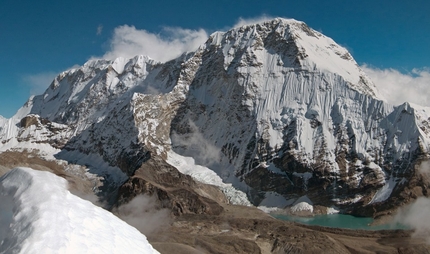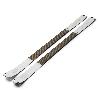Kangchung Shar North Face first ascent by Jaroslava Bansky, Zdenek Hak

 1 / 13
1 / 13 Jaroslav Bánský / Zdeněk Hák
Jaroslav Bánský / Zdeněk Hák
After the "rest" season last year we were very motivated to get back to some mountaineering projects. Nevertheless, I decided to leave bigger objectives on hold this year; the pandemic situation is not favourable anywhere in the world quite yet, so we opted for some more modest plans. I was attracted to two mountains next to each other, Kangchung Shar and Kangchung West, also called Cholo or Mount Abi. Two beautiful mountains of alpine character that are special because of their shape and steepness rather than their altitude. A bit like two Matterhorn brothers next to each other, but 2 kilometres higher. My climbing partner was my old Czech friend Jaroslav Bansky, nicknamed Banán (Banana), a member of the Czech mountain patrol.
After arriving in Kathmandu, we purchase a climbing permit for Kangchung West. Its north face looks beautiful and I have found out that Czech climbers had attempted this face in the past… Nepal is completely without tourist this year which seams strange. Most lodges remain closed, and those that are open are even more hospitable than usual.
Our trekking group is great and everything is going well. I feel great and seem to be less affected by the high altitude than usual. Everything changes though after arriving at Dhole village. I get a headache, diarrhea and feel very week. In addition, after reaching Gokyo, the weather changes and it starts snowing.
We spend two days in the lodge watching the snow fall. On the third day the weather improves and we help our trekking group to get over the glacier to Dranang before we set off towards our base camp. We leave Gokyo the next day and hike over the Ngoyumba Glacier towards our base camp that we plan to set up on yjr Gaunara Glacier. The deep snow slows us down considerably and we have to set up a bivouac on the way. We arrive under the northern walls early the next afternoon and set up our small tent on the moraine above the glacier. The plan is to carry the climbing gear right to base of the wall the next day, check the conditions there and to start climbing the following day.
I wake up with a sore throat and feel weak. Nevertheless I still get up and pack the climbing gear. I am a bit nervous and cranky and set off without waiting for my friend. I feel worse and worse. I realize that I cannot go any further and return to the tent. I am so disappointed!
I spend the next two days in the tent. The clock is ticking. We had packed food for six days, the good weather period is about to end; Banan reports worsening conditions on the mountain and I am not getting better. If we do not start tomorrow, we have to give up. We change our plans. We will try to climb Kangchung Shar. Also there are no completed attempts from the north. Only one British attempt about five years ago…
I don't feel too bad in the morning so we get going. I am very weak and my legs tremble but I don’t feel sick. After an hour and a half, we reach the start of the route. We discuss which way to go and start climbing. Ramps, corners, overhangs and hard ice, there's a bit of everything. But when I hang in my ice axes, I quickly loose power. Bananhas leads the most physically difficult pitches and breaks a trail in the snow.
e reach 5600m at about 2pm where we set up our tent. We have had enough. It is quite warm so we admire the amazing view of the Himalayas. Cho-oyu, Mt Everest, Jasemba, Nangpai-Gosum... so close to us. But the conditions look terrible. The faces are dry, filled with hard ice, no corn snow. There is sandy snow on the rocks that makes it impossible to climb. Everything we are also facing in our route. Our eyes examine the final section of the face. It has been climbed before but in totally different conditions. Well, we have something to look forward to. Some difficult mixed climbing lies in front of us and much more!
The alarm clock rings at 4am and we start climbing 1,5 hours later. It is freezing cold. The whole season has been quite cold this year in the Himalayas! We ascend over a gently sloped glacier when my heart nearly stops beating. The snow rapidly disappears below my feet and a "whoom" sounds all around. I have never heard it so loud before. Even worse, the terrain is not steep. We decide to cross the avalanche slope roped up, 30m from each other, drilling ice screws into every little island of ice we encounter. 40cm of fresh snow directly over the hard water ice. If it slides, we should stay clipped to the screws. What an idea!
Fortunately, the terrain gets steeper; hence, there is less snow left. But the climbing is tedious. The snow does not provide any support, so our calves burn on hard ice. We cannot wait to reach the ridge. The top seems close but there are still several pitches of difficult mixed terrain. Everything is harder because of the loose snow filling all corners and slabs. I drive a piton and clean the terrain above me. I drive in the next one, and keep repeating this I am not able to climb a longer pitch because I am too afraid of falling, not knowing what I'm actually climbing on.
It is almost noon when we reach the top. Uff, we've made it! Unlike Banan, I did not hope that we will make it to the top. I have never experienced such difficult climbing in the Himalayas. We make a few photos and start descending quickly. The plan is to descend all the way today. The weather gets worse and it starts to snow. We abseil to the start of the ice. We leave several pieces of gear and slings behind… Hopefully we will have enough left for the lower sections. We keep abseiling to the glacier, not noticing how warm it has become. We are back at the avalanche spot. "Whoom", this time it is Banan who gets scared. I try to advise him which way to go but if it slides, there is not much chance of survival.
Soon we are safe in our tent. We don’t stay long and pack up quickly. We will try to descend the classic route down the south face of the mountain today. We manage to find it quickly and we partially down climb, partially abseil off the edge of the glacier to the mountain base. We pack our climbing gear and continue descending all the way to the civilization. We reach Dranang before it gets dark. What a day…
The next day we meet our trekking companions in Namche Bazar. Not a happy picture. Most of them are ill like me. Half of them cannot fly back to Europe due to positive covid test. Apparently, this is not yet the right time for climbing expeditions...
The route has been called Ada’s heavenly traverse, rated TD+, in honour of the ex-chief of the Czech Mountain Patrol in the Giant Mountains and Banan’s uncle Adolf Kleps (12.9.1964-10.10.2017).
by Zdeněk Hák
Link: Facebook Zdenek Hak, Climbing Technology



 Copia link
Copia link













 See all photos
See all photos


























